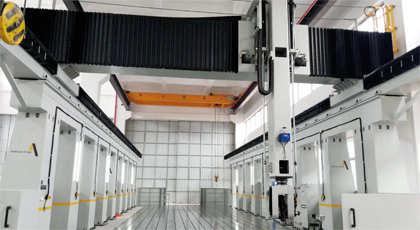In the industrial fields of wind turbine blades, sanitary ware, automobile coverings, etc., the manufacturing precision of FRP (fiberglass reinforced plastic) molds directly determines the quality boundary of the end products. With the popularity of carbon fiber composite applications, the traditional manual laminated mold has been difficult to meet the micron-level shape and position tolerance requirements, the industry is through the innovation of material formulations, digital molding technology and the depth of the fusion of intelligent monitoring system, to promote the manufacturing of glass fiber reinforced plastic molds to the direction of high-precision, long-life iterative upgrading.
A scientific proportioning of the matrix material system
Resin matrix innovation:
The mold surface gel coat is recommended to use temperature-resistant vinyl ester resins, its viscosity at 80 ℃ needs to be stabilized in the range of 350-450mPa·s, styrene volatility needs to be controlled in the amount of 1.2% or less. A German manufacturer developed nanosilica modified resin, heat distortion temperature to 185 ℃, curing shrinkage rate down to 0.05%, significantly improve the dimensional stability of the mold.
Reinforced Fiber Architecture:
The mold structural layer adopts 0/90° orthogonal carbon fiber cloth and ±45° glass fiber cloth alternately layered with carbon fiber volume fraction controlled at 35%-40%. The key load-bearing parts are implanted with 3D three-dimensional fiber fabrics, so that the interlayer shear strength is increased to 45MPa, which is 60% stronger than the traditional layup.
Functional additives regulation:
Adding 2%-3% silicon carbide particles can improve the abrasion resistance of the mold surface, together with 0.5% fumed silica thixotropic agent, to ensure that the resin does not hang in the construction of the vertical surface. Polymerization inhibitor bisphenol A dosage needs to be accurate to 0.02‰, to prevent the resin from premature gel.
Second, the digital breakthrough of mold forming process
Intelligent paving technology:
Adopting six-axis robotic arm equipped with infrared positioning system to realize the automatic cutting and accurate paving of fiber cloth. Through the pressure feedback device will lay the compaction degree stabilized at 98%±1%, eliminating the uneven thickness caused by manual operation. In wind power mold manufacturing, this technology makes the leaf root flange flatness error ≤0.15mm/m.
Vacuum introduction process optimization :
Development of a multi-stage resin runner system, with the flow rate of the main injection port set at 120g/s, and the flow rate of the branch runners automatically adjusted according to the curvature of the mold profile. Integrated pressure sensing network real-time monitoring of the resin front movement trajectory, large automotive cover mold wetting time from 8 hours to 4.5 hours, bubble residue <0.03%.
Gradient Curing Control:
Construct digital twin model of temperature field inside the mold, and implement gradient curing with partitioned temperature control technology: 40℃ pre-curing stage maintains 6 hours to eliminate internal stress; warming up to 90℃ to complete the cross-linking reaction at a rate of 1.2℃/min; 130℃ post-curing stage with ultrasonic vibration so as to make the mold Barcellian hardness reach HBa85 or above. The hardness of the mold will be HBa85 or above.
III. Surface Finishing and Life Strengthening
Nano-scale polishing treatment:
Five-axis linkage CNC polishing equipment is used, and diamond abrasives with grain size 5μm are used to mirror process the mold profile. Through online white light interferometer detection, the surface roughness Ra value ≤0.1μm, gloss (60°) ≥95GU, to meet the production needs of high-gloss spray-free products.
Metallization Enhanced Plating:
Magnetron sputtering technology is applied to deposit 2-3μm Ni-Cr alloy layer on the surface of the mold, together with the ceramic heat-barrier coating with a thickness of 0.5mm, which makes the mold's temperature resistance break through the 300℃ limit. An automotive parts manufacturers measured data show that the process makes the service life of FRP molds from 800 times to more than 2500 times.
Intelligent Health Monitoring:
A fiber Bragg grating sensor network is embedded inside the mold to monitor strain distribution and temperature gradient in real time. When the local stress exceeds 70% of the design value, the system automatically triggers an early warning and generates a structural reinforcement program, reducing the accidental damage rate of the mold by 90%.
Fourth, the whole life cycle management innovation
Introduction of blockchain technology to establish a mold digital passport, a complete record of the material batch, process parameters and maintenance.























